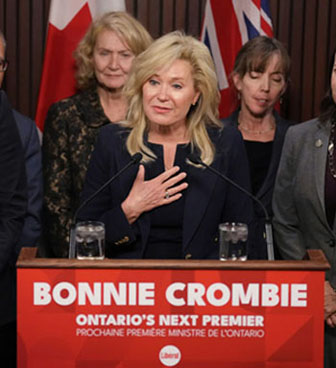Two by-elections change absolutely nothing in Ontario politics … maybe?
May 6th, 2024 | By Randall White | Category: In BriefONTARIO NOTEBOOK. RANDALL WHITE, FERNWOOD PARK, TORONTO . MONDAY, MAY 6, 2024. Two Ontario by-elections this past Thursday, May 2, 2024 (“special elections” in US parlance) changed absolutely nothing in Ontario provincial politics.
Yet various observers seem to suggest that these political housekeeping events in Canada’s most populous province may still harbour deeper meanings in the fateful 2024 US election year.
On the surface both by-elections took place in ridings won by the Ford Conservatives in the last 2022 general election, where the incumbent member subsequently resigned in pursuit of further career objectives. (Which they didn’t see happening at Queen’s Park under Doug Ford?)
Both ridings remain in Conservative hands after the 2024 by-elections. (Yawn, yawn.) With much the same degree of support the party had in 2022. (And btw many sources still misleadingly call the Ford Conservatives “PC” — for the old Ontario Progressive Conservatives of an earlier era. In my view the real Ontario PCs ended in the mid 1980s, under Bill Davis.)
(1) 2022 general election and 2024 by-elections
Lambton-Kent-Middlesex in Southwestern Ontario was won by then Conservative Labour minister Monte McNaughton in 2022, with some 59% of the riding vote. In this past Thursday’s by-election Steve Pinsonneault took the riding for the Conservatives with 57% of the vote.
Similarly, Milton in the west end of the Greater Toronto Area was won for the Conservatives by Parm Gill with 43% of the vote in 2022. This past Thursday in 2024 Zee Hamid won Milton for the Conservatives with 47% of the vote.
CTV News reported that :”’Voter disengagement’ and modest voter turnout mark PC win in Lambton-Kent-Middlesex byelection.” Sarnia News Today explained that “Low voter turnout in byelections is normal says Poli-Sci professor.”
It is sadly true enough that voter turnout in the 2022 Ontario election hit an abysmal record low of 44%. Yet setting such falling turnout trends aside (or at least holding them constant), both 2024 by-elections seem broadly in line with general voter turnout trends for such events.
(2) By-election turnout and Lambton-Kent-Middlesex

According to a study of “Voter turnout in by-elections and general elections” at the Canadian federal level, from the 1960s to the 2000s, average turnout in by-elections has most recently weighed in at about 60% of turnout in general elections.
Turnout in the 2024 by-elections in Lambton-Kent-Middlesex and Milton was about 65% of what it was for the 2022 general election in the two ridings. The “Poli-Sci professor” consulted by Sarnia News Today is right. Voter turnout in by-elections is typically lower than in general elections. There is nothing unusual about Ontario in 2024 in this respect.
Somewhere around this point, however, marks the transition from big no-surprise numbers to deeper meanings.
The last time a Liberal won the pre-eminently rural-Ontario riding of Lambton-Kent-Middlesex, for instance, was the 2007 general election. It has subsequently gone Conservative in the 2011, 2014, 2018, and 2022 general elections. No one was expecting any challenge to the current Conservative hegemony in the 2024 by-election here.
At the same time, the 2024 Liberal candidate in Lambton-Kent-Middlesex, Cathy Burghardt-Jesson, did better (some 23% of the vote) than any Liberal in the riding since 2011.
This may or may not have somewhat compensated for what some would regard as a disappointing 2024 Liberal by-election showing in Milton.
(3) Milton and Bonnie Crombie
According to CBC News Ontario specialist Mike Crawley : “Thursday’s byelection in Milton … is the first ballot box test for Bonnie Crombie since she became leader of the Ontario Liberal Party in December … As the former mayor of Mississauga, Crombie’s presence as leader should in theory boost the Liberals’ fortunes elsewhere in the 905” (or Greater Toronto Area beyond the official City of Toronto).
In the end in the 2024 Milton by-election losing Liberal candidate Galen Naidoo Harris took 38.25% of the vote — certainly no better than the 38.75% taken by losing Liberal candidate Sameera Ali in the 2022 general election.
Bonnie Crombie, it could be concluded, does have some work to do over the somewhat more than two years until (almost certainly?) the next Ontario general election on June 4, 2026. (Even so, if Ms Crombie really thought Milton was such a good Liberal bet in the spring of 2024 she would have run there herself?)
Meanwhile, Ontario’s progressive majority (the Ford Conservatives having won only 40.82% of the province-wide popular vote in 2022 — enough to give them 67% of the seats in the legislature!) might take solace from the thought that, thanks largely to the rigged voting of our current first-past-the-post electoral system, Ontario is largely a conservative province. And that is as much of an explanation of Doug Ford’s current political grip on the place as may be needed?
(4) Ontario a Conservative province?
On the other hand again, here are the results of some final back-of-the-envelope calculations I have just made, based on Wkipedia’s “List of Ontario general elections” (as confirmed by the relevant Elections Ontario resource!).
So … There have been 43 Ontario general elections so far, since the Canadian confederation of 1867. I’d suggest leaving out the first — won by the “Mauve” John Sandfield Macdonald, who provided a largely non-partisan founding regime. That leaves an even 42 Ontario general elections so far.
Of these 42 general elections Conservatives have (in broad terms and including four minority governments) “won” (at least the most if not a majority of seats) 24. Liberals have won 16, and there have also been the two third-party progressive governments of 1919–1923 (E.C. Drury’s Farmer-Labour experiment) and 1990–1995 (Bob Rae’s New Democratic Party interlude).
It could be argued that these calculations underestimate the modern Conservative dominance in Canada’s most populous province, because they include the initial nine consecutive Liberal (or as many said in the day Grit or Great Reform) governments of Ontario from 1871 to 1905.
If we confine our modern vision to the 20th century and beyond, Conservatives have won 24 elections, Liberals only 8, and the “Farmer-Labour New Democrats” 2. If we go still more modern and confine our attention to the world since 1945 (and the end of the Second World War) Conservatives have won 15 Ontario elections, Liberals 5, and New Democrats 1.
On the other hand, if we very rigorously confine our attention to the 21st century alone, during this most modern period Liberals have won 4 Ontario elections and Conservatives only 2.
CONCLUSION
My own final view of the two Ontario by-elections this past Thursday, May 2, 2024 is that they have indeed changed absolutely nothing of even small consequence in Ontario provincial politics right now.
And they probably have not all that much to do with the next Ontario election that is at the moment somewhat more than two years away!
Randall White has a PhD in political science from the University of Toronto, and worked as an Ontario public servant for a dozen years. He is also the author of Ontario 1610–1985 : A Political and Economic History and Ontario Since 1985. He has worked as an independent public policy consultant based in Ontario’s capital city since the 1980s.







